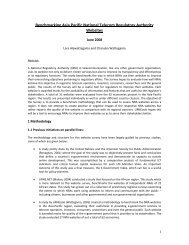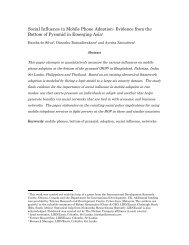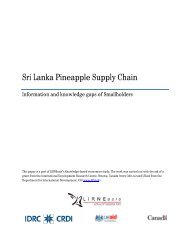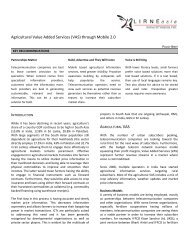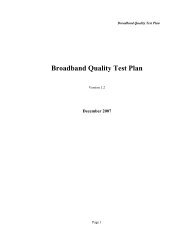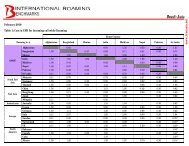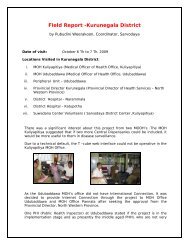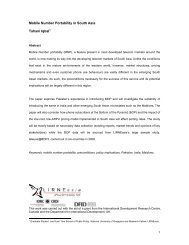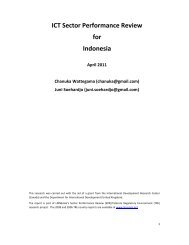Teleuse@BOP3: A Qualitative Study - LIRNEasia
Teleuse@BOP3: A Qualitative Study - LIRNEasia
Teleuse@BOP3: A Qualitative Study - LIRNEasia
You also want an ePaper? Increase the reach of your titles
YUMPU automatically turns print PDFs into web optimized ePapers that Google loves.
Review of Quantitative Findings<br />
Facts and Figures<br />
The data from the quantitative study is analyzed by <strong>LIRNEasia</strong> personnel. Some of the key findings which informed<br />
the probe areas of qualitative research and consequently this report are briefly discussed as under:<br />
Demographic Trends<br />
Access to a phone<br />
Gender<br />
Age<br />
• Considerably lower use of public access phones in Pakistan compared to other South Asian countries is<br />
observed. It is also observed that Philippines showed the lowest use of public access phones.<br />
• In India, Philippines and Thailand people owning mobiles see more benefits.<br />
• Considerably greater gender differences are seen among South Asian countries than in South East Asian<br />
countries; greatest divide is seen in Pakistan and a slightly greater percentage of females than males owned<br />
mobiles among South East Asian countries.<br />
• In South Asia, public access phone use considerably is seen to be higher among males than females. The<br />
greatest difference in such behavior is observed in Pakistan.<br />
• It is found that men used the phone more for business transactions than women. Such differences are<br />
greater in South Asian countries as compared to the South East Asian countries. 66% of Bangladeshi<br />
women used the phone everyday for such communication and only 8% of Sri Lankan and Pakistani women<br />
showed such teleusage.<br />
• The quantitative research showed that in Bangladesh, Pakistan, Sri Lanka, Philippines and Thailand younger<br />
people are more likely to have more than one SIM. In India, however, age is not a significant variable.<br />
• On an average, a greater percentage of respondents belonging to the 15-24 years age group are found to be<br />
making use of cost-cutting strategies than the older age groups.<br />
11




